Anti-Counterfeiting Measures
Anti-counterfeiting measures that can be confirmed by touch
Intaglio printing
Notes are printed with ink that rises higher than the ink on older notes, giving them a textured feeling when touched.
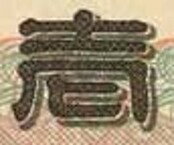 Series-F 10,000 yen note
Series-F 10,000 yen note
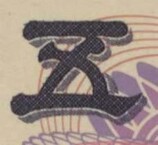 Series-F 5,000 yen note
Series-F 5,000 yen note
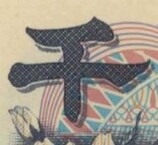 Series-F 1,000 yen note
Series-F 1,000 yen note
Tactile marks
The tactile mark, shaped with 11 diagonal lines for excellent finger sensitivity, is differently positioned to facilitate easy identification of denominations.
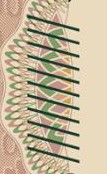 Series-F 10,000 yen note
Series-F 10,000 yen note
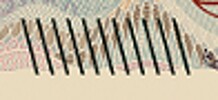 Series-F 5,000 yen note
Series-F 5,000 yen note
 Series-F 1,000 yen note
Series-F 1,000 yen note
Anti-counterfeiting measures that can be confirmed with watermarks
Watermark and high-definition watermark
Watermarking is a technique to prevent counterfeiting by producing variations in the thickness of the paper. The watermark has sharp and spatial gradation in its image.
There are watermarks of SHIBUSAWA Eiichi, TSUDA Umeko, KITASATO Shibasaburo, and the Shurei Gate in Okinawa; the same portraits and landscape as the ones found on the front of the notes.
In addition to the intricate portrait watermark, finely crafted continuous patterns (high-definition watermark) are applied around the portrait.
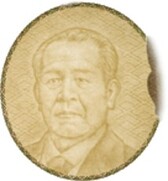 Series-F 10,000 yen note
Series-F 10,000 yen note
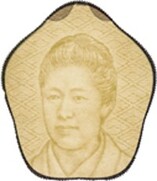 Series-F 5,000 yen note
Series-F 5,000 yen note
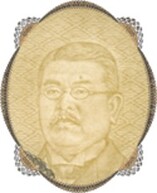 Series-F 1,000 yen note
Series-F 1,000 yen note
Watermark-bar-pattern
Watermarks in bar patterns are embedded in the paper. When seen against the light, the Series-F 10,000 yen note has 3 bars, the Series-F 5,000 yen note has 2 bars, and the Series-F 1,000 yen note has 1 bar.
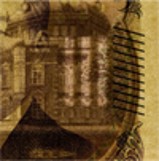 Series-F 10,000 yen note
Series-F 10,000 yen note
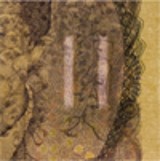 Series-F 5,000 yen note
Series-F 5,000 yen note
 Series-F 1,000 yen note
Series-F 1,000 yen note
Anti-counterfeiting measures that can be confirmed by tilting
3D Hologram
It's the world's first adoption in banknotes. By tilting, the banknote left or right, the three-dimensional portrait rotates, and other designs change depending on the viewing angle.
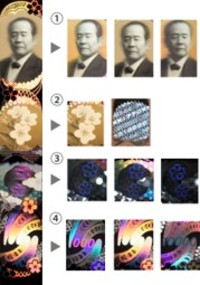 Series-F 10,000 yen note
Series-F 10,000 yen note
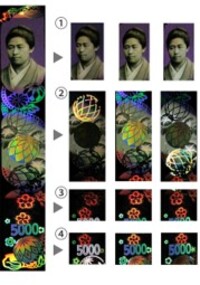 Series-F 5,000 yen note
Series-F 5,000 yen note
 Series-F 1,000 yen note
Series-F 1,000 yen note
Latent images
When tilting a note, the denomination “10000”, “5000” and “2000” appears on the front side, and “NIPPON” appears on the reverse side.
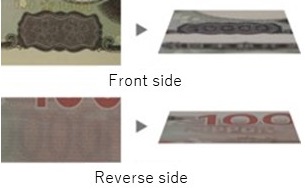 Series-F 10,000 yen note
Series-F 10,000 yen note
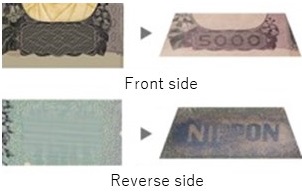 Series-F 5,000 yen note
Series-F 5,000 yen note
 Series-F 1,000 yen note
Series-F 1,000 yen note
Pearl ink
Not visible from the front, but when tilting a note, a pink pattern emerges at the center of either end of the note.
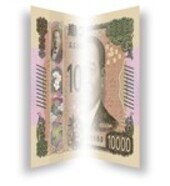 Series-F 10,000 yen note
Series-F 10,000 yen note
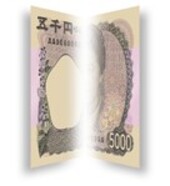 Series-F 5,000 yen note
Series-F 5,000 yen note
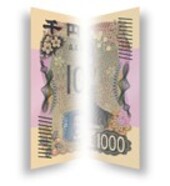 Series-F 1,000 yen note
Series-F 1,000 yen note
Anti-counterfeiting measures that can be confirmed with tools
Microprinting
“NIPPONGINKO” is printed in microscript that cannot be easily reproduced on color copy machines.
The letters can be discerned when magnified using a tool such as a loupe (magnifying glass).
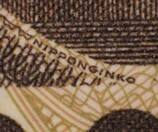 Series-F 10,000 yen note
Series-F 10,000 yen note
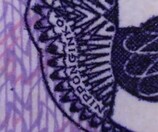 Series-F 5,000 yen note
Series-F 5,000 yen note
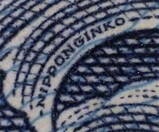 Series-F 1,000 yen note
Series-F 1,000 yen note
Luminescent ink
When ultraviolet light is shone on a note, the seal of the Governor of the Bank of Japan on the front side, and part of the background pattern on either side, become luminous.
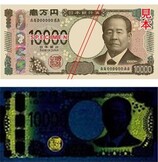 Series-F 10,000 yen note
Series-F 10,000 yen note
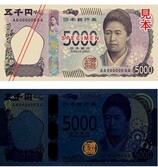 Series-F 5,000 yen note
Series-F 5,000 yen note
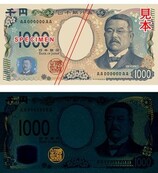 Series-F 1,000 yen note
Series-F 1,000 yen note
Others
Various anti-counterfeit measures are used on banknotes, including technologies that make it easy to identify counterfeit notes by sight and touch, as well as technologies that make it difficult to create counterfeit notes using computers and other such equipment. There are also technologies to enhance the counterfeit detection capabilities of cash handling machines (ATMs, vending machines, etc.).This last technology is to prevent counterfeits that target machines such as the widely available vending machines. In order to ensure that these kinds of counterfeit attempts are identified, the banknotes incorporate measures that make it easy to check the validity of the notes in cash-handling machines.
Page Top
Intaglio printing
Notes are printed with ink that rises higher than the ink on older notes, giving them a textured feeling when touched.



Tactile marks
In place of watermarking, tactile marks by intaglio printing with a textured feeling are employed to help the visually handicapped distinguish different notes with their fingers.Identifying marks are shaped differently for each type of note in order to make it easier to differentiate between the different notes.
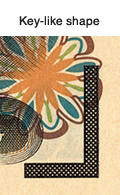
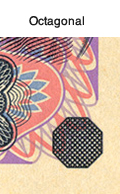
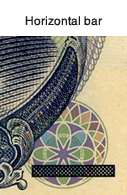
Watermark
Watermarking is a technique to prevent counterfeiting by producing variations in the thickness of the paper. The watermark has sharp and spatial gradation in its image.
There are watermarks of Yukichi Fukuzawa, Ichiyo Higuchi, Hideyo Noguchi, and the Shurei Gate in Okinawa; the same portraits and landscape as the ones found on the front of the notes.
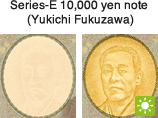

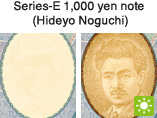
Watermark-bar-pattern
Watermarks in bar patterns are embedded in the paper. When seen against the light, the Series-E 10,000 yen note has 3 bars, the Series-E 5,000 yen note has 2 bars, and the Series-E 1,000 yen note has 1 bar.
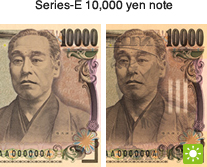
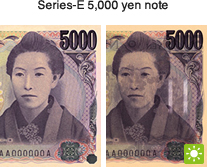
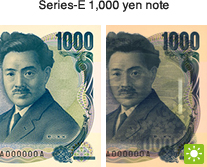
Hologram
When seen from different angles, the characters for the denomination “10000”, a design of “日” from “日本銀行” meaning the Bank of Japan, and the image of a cherry tree appear.
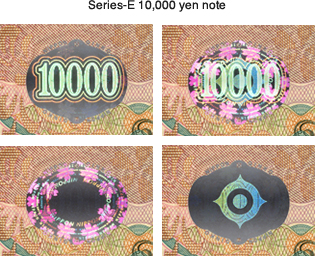
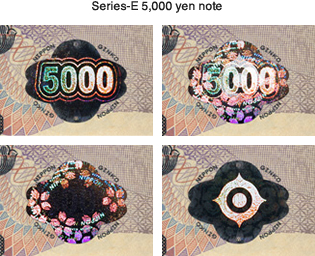
Latent images
When tilting a note, the denomination “10000”, “5000” and “2000” appears on the front side, and “NIPPON” appears on the reverse side.
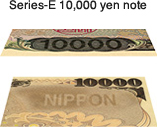
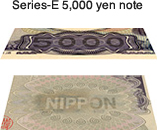
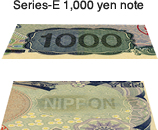
Pearl patterns as latent images
When the note is tilted, depending on the angle, the characters “千円” or the denomination “1000” produced by pearl printing appear as latent images in the bar on the bottom left of the note.

Pearl ink
Not visible from the front, but when tilting a note, a pink pattern emerges at the center of either end of the note.
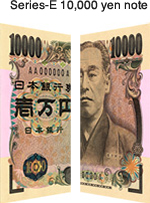
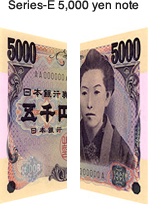
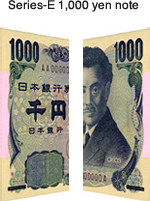
Microprinting
“NIPPONGINKO” is printed in microscript that cannot be easily reproduced on color copy machines.
The letters can be discerned when magnified using a tool such as a loupe (magnifying glass).
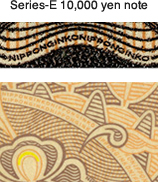
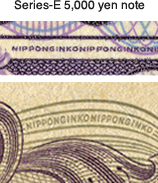
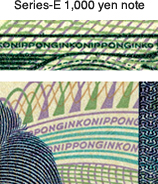
Luminescent ink
When ultraviolet light is shone on a note, the seal of the Governor of the Bank of Japan on the front side, and part of the background pattern on either side, become luminous.
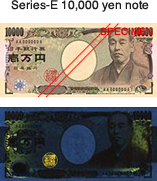
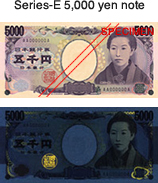
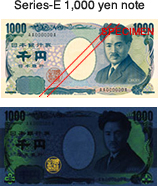
Color shifting inks
When tilting a note, the characters for “2000” change color from blue green to purple.
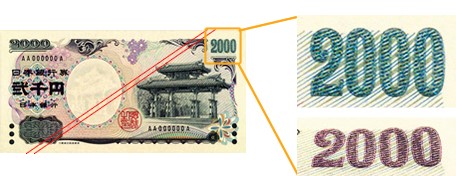
Intaglio printing
Notes are printed with ink that rises higher than the ink on older notes, giving them a textured feeling when touched.

Tactile marks
In place of watermarking, tactile marks by intaglio printing with a textured feeling are employed to help the visually handicapped distinguish different notes with their fingers.Identifying marks are shaped differently for each type of note in order to make it easier to differentiate between the different notes.
Japanese hiragana character “に” [read as “ni”] in Braille(Series-D 2,000 yen note)
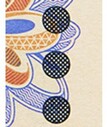
Watermark
Watermarking is a technique to prevent counterfeiting by producing variations in the thickness of the paper. The watermark has sharp and spatial gradation in its image.
There is watermark of the Shurei Gate in Okinawa; the same landscape as the one found on the front of the note.
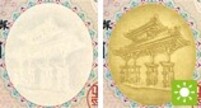
Latent images
When tilting a note, the denomination “2000” appears on the front side, and “NIPPON” appears on the reverse side.
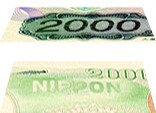
Pearl ink
Not visible from the front, but when tilting a note, a pink pattern emerges at the center of either end of the note.
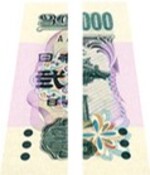
Watermark
Watermarks are created by producing variations in the thickness of the paper, and can be either light or shaded. They are combined to pattern banknotes elaborately.
Watermarks also include tactile marks to help the visually impaired people distinguish different denominations.
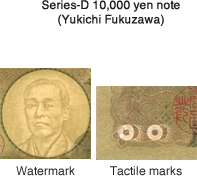
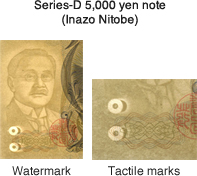
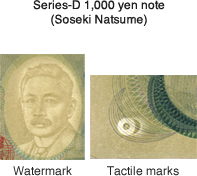
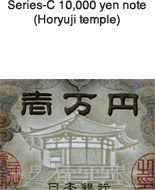
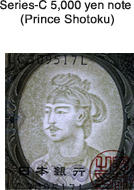
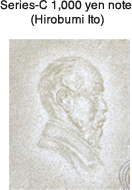
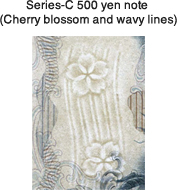
Intaglio printing
Image designs of the values and portraits on banknotes are thickly printed to give a notable texture.
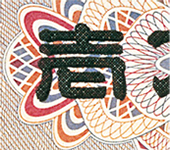
Series-D 10,000 yen note
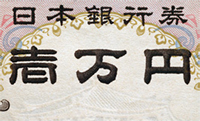
Series-C 10,000 yen note
Ultrafine-line printing
Banknote designs are drawn with extremely fine lines. Such fine lines can hardly be replicated by color copy machines, or by ordinary printing equipment or similar devices.
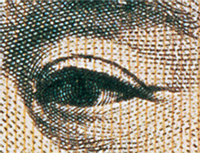
Series-D 10,000 yen note
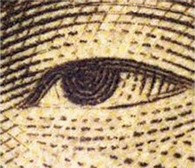
Series-C 10,000 yen note

 Security Products
Security Products